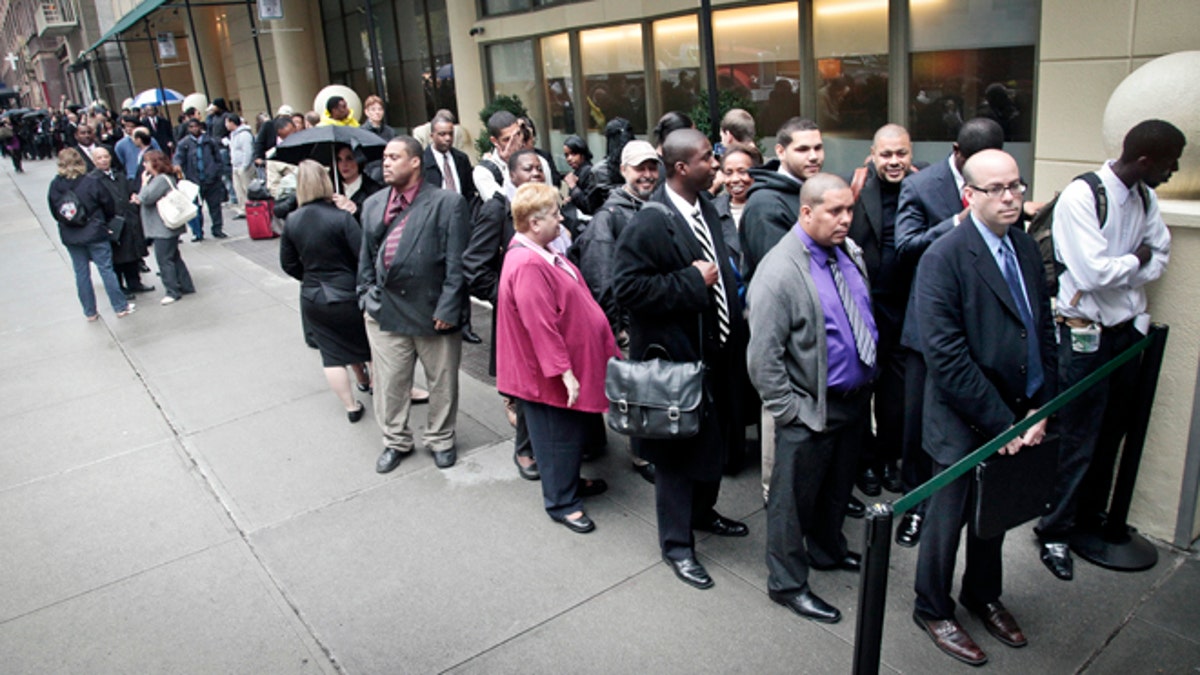
Job seekers wait in line to see employers at a National Career Fairs' job fair in New York. (AP)
Friday, forecasters expect the Labor Department to report the economy added 80,000 jobs in November—substantially less than the 171,000 added the prior month. As budgets talks are progressing disappointing jobs reports could likely continue into the New Year.
Factors contributing to a slowdown in jobs creation include temporary displacements caused by Hurricane Sandy and business worries that President Obama and Congressional Republicans will not reach a compromise to avert the fiscal cliff. However, looming larger has been a slowdown in growth of consumer spending in recent months, and the continuing nagging effects of the trade deficit on economic activity.
The economy must add more than 349,000 jobs each month for three years to lower unemployment to 6 percent and that is not likely with current policies.
[pullquote]
Most analysts see the unemployment rate inching up to 8.0 percent, while a few see it remaining steady. The wildcard is the number of adults actually working or seeking jobs—the measure of the labor force used to calculate the unemployment rate.
Labor force participation is lower today than when President Obama took office and the recovery began, and factoring in discouraged adults and others working part-time that would prefer full time work, the unemployment rate is 14.6 percent.
Convincing millions more adults they don’t need or want a job has been Washington’s most effective jobs program, despite trillions in new stimulus spending, industrial policies, targeted tax cuts, and social programs intended to boost demand.
Though Congress may avoid Sequestration, some temporary tax cuts, such as reduced social security payroll taxes and elements of the Bush tax cuts benefiting high income families, will likely lapse, and some combination of savings in entitlements and defense spending will be accomplished. The package that emerges will likely cut the annual deficit by about $250 billion.
Economists agree that inadequate demand for what Americans make is holding back growth and jobs creation, and President Obama wants $50 billion in new stimulus spending. However, the combination of higher taxes, reduced entitlement and domestic spending and some additional public works projects would reduce the budget deficit and domestic demand by about $200 billion in 2013. This would curb GDP growth by about 1 or 2 percentage points, and could raise unemployment to about 10 percent.
During the early years of the recovery consumer demand did expand as the household deleveraging process ended; however, too many of those dollars were spent on imports that did not return to buy U.S. exports—the gap between new imports and new exports was lost demand for U.S. goods and services.
At about $500 billion, the trade deficit is almost entirely attributable to the gaps in trade with China and on oil.
Confronting China more forcefully about its undervalued currency and other mercantilist practices and opening up more offshore and Alaskan oil reserves for development could cut the trade deficit in half, jump start robust growth and create 5 million new jobs, and offer the opportunity for more substantial deficit reduction.
